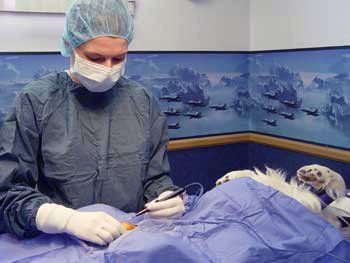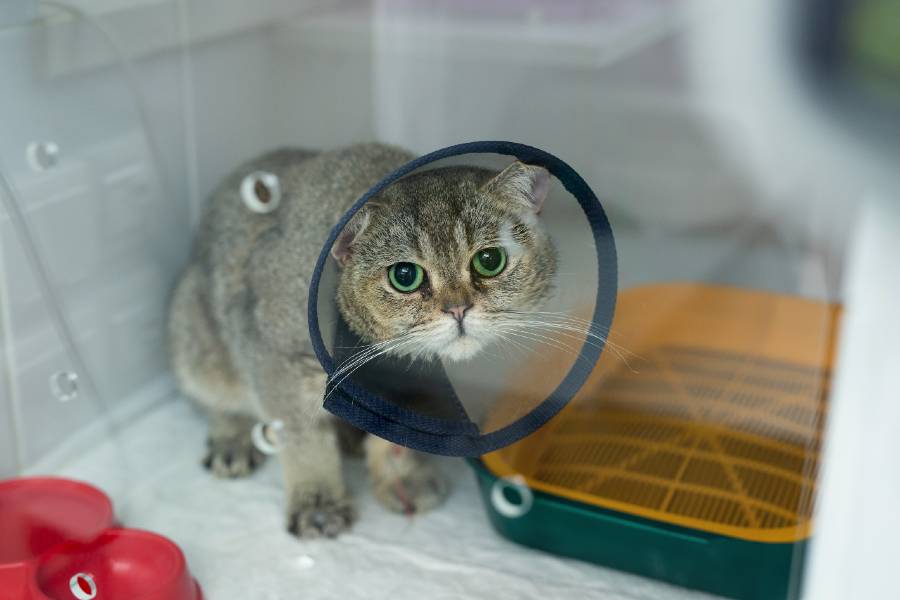Surgery (jump to spay/neuter)
Whenever a member of your family needs surgery—human or animal—it is a scary time. We get that at Pet Medical Center and want to be sure you have all the information you need to feel comfortable when your loved ones need additional care.
We pride ourselves in providing excellent surgical care for your pets. Our doctor performs routine spays and neuters, as well as lump removals, tooth extractions and a few miscellaneous procedures.
Each and every veterinary surgery we perform at Pet Medical Center uses high standards of care. Here is what you can expect when you bring a pet in for any surgery, including spaying, neutering, and dental procedures.
Surgeries are typically preformed on Monday and Thursday mornings. Sometimes special arrangements will be made for a different day to accommodate the needs of the patient. Generally, surgeries do require some hospitalization time. All surgery patients must be fasted after 10:00 PM the night before their procedure (water is okay!). A staff member will schedule a drop-off time for surgery check-in; usually between 7AM -8AM. This ensures an appropriate amount of time for the doctor to evaluate the patient before the surgery begins. After-surgery pick-up is usually anytime after 3:00 PM the day of, but may change depending on the patient. You will be notified if your pick-up time needs to be changed after it has been scheduled.
Our facility is equipped with a surgical cutting laser which can replace the use of a scalpel blade. This surgical laser cauterizes blood vessels as it cuts, reducing blood loss, pain, swelling, and inflammation. We also have a therapy laser that can be used post-operation. This laser stimulates blood flow in the surgery site and promotes healing while reducing pain and swelling.
What happens when my pet is in surgery?
Surgical Preparation
We clip the hair from the skin surrounding the surgical site and antiseptically scrub it. The surgical personnel will scrub, cap, mask, gown, and glove prior to entering the surgical suite. All of the surgical equipment is sterilized before the operation begins.
Fluids
Almost all of our surgical patients have an IV (intravenous) catheter placed prior to surgery. This allows us immediate access for any medications and fluids required to support your pet throughout surgery. Patients that receive intravenous fluids during the procedure have a small area on one of the front legs clipped to allow sterile placement of the intravenous catheter. The site may still be bandaged at your pet’s release time. You may remove the bandage later in the day.
Warming Methods
While under anesthesia, it is very common for pets to lose body heat and develop a lowered body temperature, which can slow recovery times and result in complications. This is why we place all surgical and dental patients on heated blankets to maintain healthy body temperature throughout the anesthetic period.
Anesthesia
Local or general anesthesia may be used. Some risk is involved depending upon the general condition of your pet, but precautions are taken to minimize this risk. Anesthesia protocols are tailored to your pet’s individual needs. If a surgical procedure needs to be delayed for any reason, we will contact you immediately to discuss the situation. Isoflorane gas anesthesia is used. These are the safest anesthetic agents available for your pet.
Monitor
Heart rate, continuous ECG (electrocardiogram) tracing, respiratory rate, blood pressure, pulse, and oxygenation saturation are all constantly monitored throughout the procedure by a certified veterinary technician. That technician will monitor your pet before, during, and after surgery.
Laser Surgery
The laser uses a very concentrated beam of light to make incisions, and cauterize tissues. This technique has several advantages over both a scalpel blade and electrocautery; the laser:
- provides a much more precise incision that results in less tissue swelling and decreased cellular reaction. (This means less pain)
- minimizes bleeding and swelling by sealing off blood vessels and nerve endings.
- sterilizes the tissues it comes in contact with, minimizing infections.
Pain Relief
All surgical veterinary patients receive appropriate pain control pre- and post-surgery to minimize discomfort and optimize healing.
Post-Surgical Care
Your pet’s well-being is monitored continuously by our veterinarians and trained staff until he or she is released back into your care. A trained surgical technician will discuss any home care instructions with you during a special discharge appointment.
Do I need to spay or neuter my pet?
PMC knows spaying or neutering is a responsible choice that benefits pets, their families, and society as a whole. In this country, each year millions of cats and dogs are euthanized needlessly—a trend we want to change.
What are the benefits for your pet?
Dogs
- If your female dog is spayed before her first heat cycle, her chances of breast cancer are close to 0%.
- Females who are not spayed can go into heat and potentially become pregnant.
- The chance of females suffering from an infected uterus or mammary tumors is reduced.
- Around the age of 5, male dogs may begin to have issues with their prostate glands. Neutering will help to lessen the chance of prostate problems.
Cats
The noise factor of a cat in heat cannot be denied. Yes, it is loud and annoying to surrounding humans, but it is uncomfortable for her as well. Don’t be fooled if all is quiet; a cat’s reproductive system can go into dormant phases.
- Cats can have 2–3 litters of kittens a year.
- Adult females can be in heat as often as every 2 weeks for 6 months.
- When male cats are neutered the risk of marking behavior is drastically reduced.
How much does it cost to spay or neuter my animal?
For any surgical procedure, even common ones like spaying and neutering, there are multiple factors that come into play and can impact pricing.
For that reason, all pets must come in for an appointment first to discuss their specific condition, treatment plan, and pricing when we schedule the procedure.





